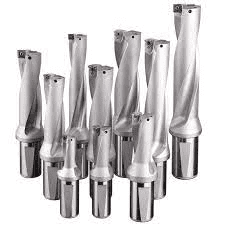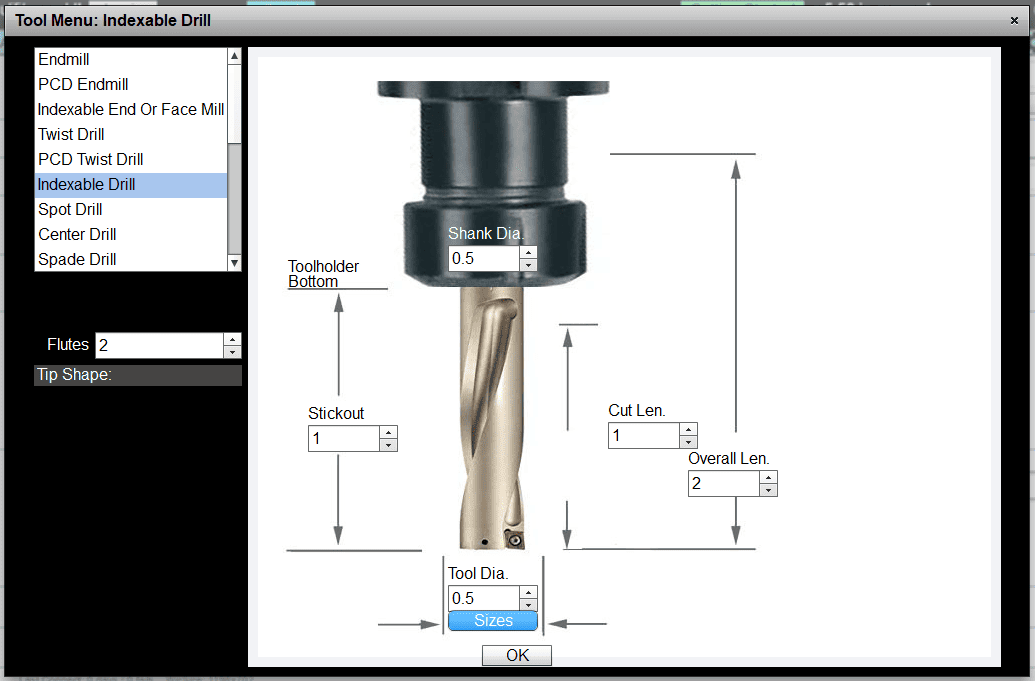The advent of indexable drills, often called “insert drill,” has revolutionized the world of drilling. They are the game-changers that have opened the door to heightened productivity and superior hole quality in modern manufacturing. Intrigued? Let’s embark on this journey to discover the transformative potential of these drills, particularly the insert drill.
Short Summary
- Indexable insert drills offer enhanced productivity, superior hole quality & extended tool life.
- Consider the material, dimensions of the hole & desired surface finish when selecting an indexable drill.
- Regular maintenance and care can optimize performance and extend the lifespan of your drill.
Understanding Indexable Drills

Indexable insert drills, known for their versatility in general, plunge, and stack drilling applications, have become an outstanding choice for a range of drilling tasks. With their diameter varying from 15 – 160 mm (.590 – 6.299 inch) in many lines of indexable insert drills, they offer a wide range of sizes to choose from.
But what sets them apart? The answer lies in their enhanced productivity, superior hole quality, and extended tool life, all made possible by their unique design and modern technology.
Components of an Indexable Drill
At the heart of an indexable drill are two primary components: the tool body and the inserts. The tool body, the backbone of the drill, provides the requisite support and stability.
The inserts, on the other hand, are the workhorses. They are the cutting components that make drilling possible. Together, they form a partnership that brings precision and efficiency to the drilling process.
Benefits of Using Indexable Drills
The benefits of using indexable insert drills are multiple. They serve up.
- Greater cutting speeds
- Higher metal removal rates
- Improved surface finishes
- Extended tool life
But that’s not all. They also offer versatility, enabling multiple operations to be executed with a single tool.
Indeed, the use of indexable insert drills can lead to notable cost savings through enhanced stability, adaptability, increased productivity, and reduced tool expenses.
Indexable Drills vs Spade Drills
Indexable drills and spade drills, both with their unique advantages, are often juxtaposed. Indexable drills, with their securely fastened inserts in a tool body, are more economical for larger holes.
Spade drills, on the other hand, are known for their spearheaded inserts and improved material removal rates. Spade Drills can also cover a wide range of hole sizes just by swapping inserts whereas indexable drills are only good for one hole size.
The choice between the two often boils down to the specific requirements of the task at hand.
Choosing the Right Indexable Insert Drill for Your Application

How do you choose the right indexable insert drill for your application? The answer lies in a careful consideration of several factors. These include:
- The material to be drilled
- The dimensions of the hole
- The desired surface finish
- The requirements for the application and production levels
When selecting an indexable insert drill, it is important to consider the material to be drilled.
Material Considerations
When it comes to choosing the right indexable drill, the material to be drilled is of paramount importance. Different materials have distinct characteristics that can affect the performance of the drill, such as wear resistance, heat resistance, and cutting speed.
Indexable insert drills themselves can be composed of a variety of materials including:
- Cermet
- Ceramics
- Polycrystalline cubic boron nitride (PCBN)
- Polycrystalline diamond (PCD)
Hence, it’s essential to match the drill material with the material being drilled, taking into account the cutting conditions and the desired performance.
Drill Diameter and Depth
The diameter and depth of the hole you intend to drill can significantly influence your choice of an indexable drill. The general rule of thumb is that the maximum ratio of hole depth to drill diameter for conventional indexable drills is around 4:1. However, the ideal dimensions can vary based on the material being drilled and the specific insert drill being used.
For example, when drilling harder materials such as stainless steel, the ideal ratio may be closer to the ideal ratio.
Cutting Conditions
The cutting conditions, which encompass factors like the material being drilled, the wear resistance of the insert, and the cutting speed, can greatly impact the performance of an indexable insert drill. Hence, selecting the right insert and cutting speed is crucial to ensure consistent results even in difficult conditions.
Range of Indexable Insert Drills
The range of indexable insert drills available can be quite extensive, varying from 19.5mm to 74mm in diameter and up to 6xD in drilling depth. Renowned brands like Sandvik Coromant, Iscar, and Kennametal offer a variety of options, each with its unique features and advantages.
Popular Brands
Renowned brands like Sandvik Coromant and Kennametal have become synonymous with high-quality indexable insert drills. Sandvik, a Swedish manufacturer, specializes in metal cutting tools, while Kennametal, an American manufacturer, is known for its range of drilling tools.
Both companies have a long history of producing reliable and durable tools that are designed to last.
Product Comparison
Comparing different indexable insert drills can be a bit like comparing apples and oranges. Each has its unique features and advantages, and your choice will likely boil down to your specific needs and the filter you apply to make the right decision.
However, some commonalities exist. Most notably, they provide higher permissible speeds, greater versatility, and the ability to operate at much higher speeds than solid twist drills.
Tips for Optimizing Indexable Insert Drill Performance
To get the most out of your indexable insert drill, it’s essential to pay attention to certain factors. These include:
- The type of material being drilled
- Hole depth as measured in diameters. The use of indexable drills is generally limited to shorter hole depths. The maximum ration of hole depth to drill diameter for conventional indexable drills is about 4:1. So, a 1" indexable drill can make a hole up to 4" deep.
- The utilization of through-coolant drills
- The production levels of your shop
- The geometry of the drill
- The capacity to renew the cutting edge.
By taking these factors into consideration, you can ensure that your drill is performing optimally.
Runout and Its Impact on Tool Life
Radial runout is a measure of how far off the centerline of the drill is from that of the spindle. Generally, you want less than 0.005" radial runout for the best indexable drill results. In fact, insert drills are so sensitive to runout that their use is not recommended for drill presses because they can't hold the same tolerances as machining centers and CNC lathes.
Proper Insert Selection
Selecting the correct insert for the specified application is crucial as it can influence the drill’s performance, the quality of the finished product, and the operation’s total cost. Factors to consider include:
- The material being drilled
- The type of operation
- The desired surface finish
- The hole size
The material being drilled should be taken into account when selecting an insert. Different materials require different cutting.
Proper Chip Evacuation
Proper chip evacuation is essential to achieving the best performance with your insert drill. Through spindle coolant can greatly improve your chip evacuation and should be used wherever its available.
Interrupted Cuts
Any time an insert drill is used to cut into an uneven or angled surface it will be facing an interrupted cut until it has reached a depth where it has achieved balance cutting across the entire diameter of the hole. During this time, the user should reduce the feed rate by about 50%. The same precautions should be taken if the drill will exit an uneven or angled surface.
Insert Drill Speeds and Feeds
Our G-Wizard Feeds and Speeds Calculator is capable of delivering numbers for Insert Drills. First, set the tool type to be an Indexable Drill:

Be sure to enter all the geometry parameters. Since the range of inserts that are available is huge, you'll want to also fill in the Manufacturer's Recommended Chipload and Surface Speed for the insert drill.
Maintenance and Care
Just like any tool, an indexable insert drill requires regular maintenance and care to guarantee its durability and effectiveness. Here are some tips for maintaining your drill:
- Ensure the correct center height.
- Keep the tool clean.
- Increase coolant flow.
- Inspect the drill regularly.
- Store it properly.
By following these maintenance tips, you can ensure that your indexable insert drill remains in good condition and performs effectively.
Proper maintenance and care can extend its lifespan, optimize its performance, minimize accidents, and enhance the overall efficiency of the drill.
Troubleshooting Common Issues
Like all tools, indexable insert drills are not immune to issues. Typical problems include:
- Poor surface finish
- Chipping
- Breakage
- Inadequate chip evacuation
- Potential safety risks when increasing to full speeds and feeds.
Most of these issues can be addressed by correct insert selection, appropriate cutting conditions, and proper tool maintenance.
Video Tutorials and Resources
How to achieve good chip formation (and hence evacuation) in your insert drill:
Learning to use indexable insert drills effectively can be made easier with the help of video tutorials and resources available online. They provide a visual guide to the process and can help you find the best way to demystify the use of these powerful tools.
Indexable insert drills are a great way to quickly and accurately drill holes in a variety of materials.
How-to Videos: Use Your Indexable Drill as a Boring Bar
You can save time on your CNC Lathe by using y our indexable drill as a Boring Bar:
Summary
We have taken a deep dive into the world of indexable insert drills, exploring their components, advantages, and how to select the right one for specific applications.
Indexable insert drills are more than just tools; they are game-changers, transforming the way we approach drilling tasks. By understanding their potential and learning to use them effectively, we can unlock new levels of productivity and quality. So let’s harness the power of these drills and redefine what’s possible in our manufacturing processes.
Frequently Asked Questions
What is an insert drill?
Insert drills have a hardened steel body with cutting inserts at the end, typically two overlapping inserts - central and peripheral. They achieve hold diameter tolerance of +0.25mm.
What is the difference between a drill and an insert drill?
A drill is a cutting tool with one or more edges, while an insert drill has inserts that are clamped into its body that provide the cutting edges. The latter requires specific tooling designed to accept the inserts.
What factors should be considered when choosing an indexable insert drill?
When choosing an indexable insert drill, the material to be drilled, hole dimensions, surface finish, and application requirements should all be taken into account to ensure the best results.
How can I optimize the performance of my indexable insert drill?
To maximize the efficiency of your indexable insert drill, take into account the material being drilled, use through-coolant drills, factor in production levels, consider the drill geometry, and keep the cutting edge fresh.
By understanding the material being drilled, you can select the right drill for the job. Through-coolant drills can help reduce heat buildup and extend tool life. The geometry of the drill should also be considered to ensure the best performance.
Be the first to know about updates at CNC Cookbook
Join our newsletter to get updates on what's next at CNC Cookbook.